My Sabai Thai Trip
I spent a little over 30 days in Thailand and I learned a great deal about Thai Buddhist culture and how things things are for monks outside of the vinaya saṅgha. What did I learn?

Uncle Sam’s Banana Farm
Uncle Sam’s Banana Farm
First of all, this trip was well needed. Sabai means to be comfortable and relaxed. I really needed to be comfortable and relaxed and the goal was achieved. I had spent the previous 5 months at The International Institute of Theravāda (IIT) and the learning and study demands had been very stressful. I spent most of my time visiting Uncle Sam who was a Thai supporter I met in Kaua’i, HI. In Hawai’i, we use the word uncle as a respectful prefix for older people. It has nothing to do with blood lines.
I arrived on the 27th of April and Uncle Sam brought me to his house. His very small village is about 25 minutes away from Nong Khai which is right near the Laos border crossing bridge. He had recently built a 2 bedroom house on a 10 acre banana farm and since we both wake up before dawnrise, it was monastic-legal for me to stay there. I did however spend some time in other places.
The main part of his village is not very big and maybe the size of IIT. You can easily walk from each end of the places where the houses are in five or ten minutes. Just on the outskirts of the village are 2 monasteries; a village monastery on one end and a forest monastery on the other end. Uncle Sam did not want me living at the village monastery and there was one old monk living in the forest monastery alone by himself. Uncle Sam brought me to meet the monk and to select a kuti (small living hut), but the kutis were not livable because nobody has lived there for a very long time. It was decided I would live in the Buddha Hall, but it also needed a big cleanup first. Because it was so hot (there was a heatwave while I was there), we procrastinated on the cleanup job but eventually got around to cleaning the building. It took 4 people 3 hours to clean the hall to an acceptable level.
The normal daily routine would be that Uncle Sam would drop me off with the forest monk in the morning and the two of us would go for alms together. The route that we took was very small and we would simply walk down the street and wait a few minutes at one end. After that, we would turn around and villagers would wait for us on the same road. We were normally offered food on the way back, but sometimes, we were given food on the way up. After alms we would eat together and share what we received. With the Google Translate app on my phone, I was able to ask the monk questions and talk with him.

We would eat at Ajahn’s Kuti at the Forest Monastery
He was two months senior to me, but was a lot older than I was in human years. He usd money and even cooked for himself, but he had a good attitude towards Buddhism and was different from the village monks. He could not digest the sticky rice well, so he was cooking rice for himself. He was not making lots of money and that was not his priority. The money he received was enough to survive which included even buying his own drinking water. He would sweep the grounds daily and had his routine. I was very respectful to him and bowed down to him every chance I could, usually once or twice per day. In return, he also recognized my desire to follow vinaya and fully supported it.
Normally the majority of monks don’t like other monks who live without using money because it sort of spoils the party when the lay people learn that monks are not supposed to use money. However, this monk was very respectful of my practice and would tell the supporters not to give me money when those rare chances arrived.
I went to two house chantings and also two chantings at the forest monastery. These situations are common in Thailand, so It was an interesting learning experience for me. There was also money there, but Uncle Sam instructed the donors not to give me any money in a discrete way. It would have been legal if Uncle Sam took the money and then invited me for things but it was more trouble than it was worth to explain to him. I’m not sure what happened, but I think the money was just not given during those times. Nevertheless, some donors from Kaua’i found out about my trip and donated 9000 baht to Uncle Sam for my expenses. In addition, the Kaua’i group paid for the airplane tickets from Sri Lanka to Thailand plus a domestic ticket.
During our group meals at some of the village houses, I ate with my bowl. I was the only one who did this and it seemed strange to the local people. The Forest monk explained to the lay people that eating out of a bowl was not strange and it was something monks should actually do. The two of us got along well. Although I don’t like to see monks accepting money, I must admit, I was happy to see him get my share of money during the two times money was offered to us on the street. However, it was not common to be offered money.
Visit to Wat Wai Kooltharam.
Before leaving Sri Lanka, I asked a Thai monk from IIT for a reputable monastery near Non Khai so that I could listen to the pātimokkha (recitation of the 227 monk rules). It is a duty for all monks to attend on the full and new moon days. We called the abbot and asked about attending the pātimokkha but he said, “I’m sorry we used to have two monks who could recite the pātimokkha, but now they left and we don’t have anyone who can perform the recitation.” I said (through Uncle Sam), “If you want, I can recite it for you.” They accepted and told me to come the night before because they do it in the morning. I arrived the night before and In the morning, I went for alms in their local city.
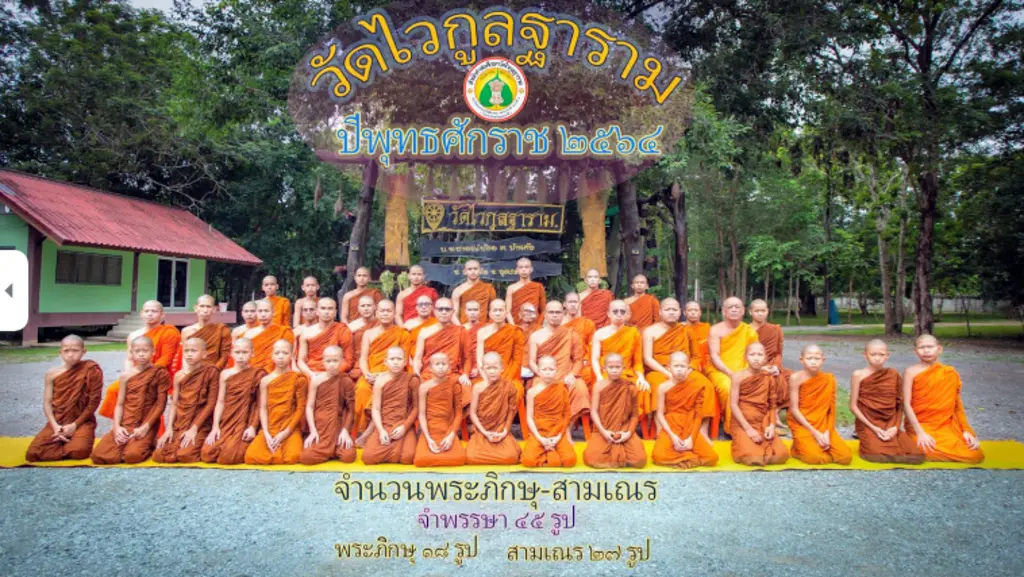
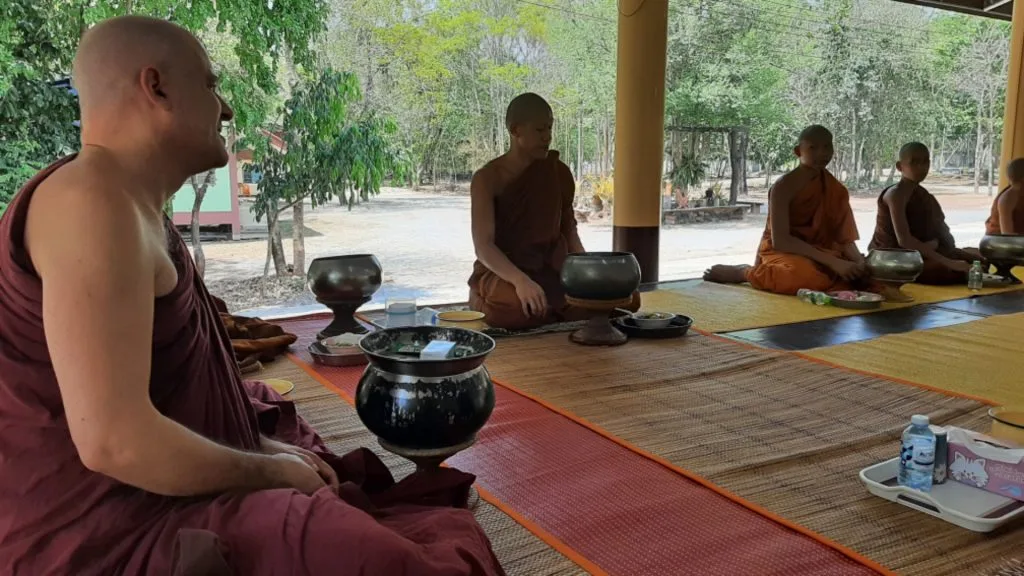
For alms, we had a group of monks who went to the city by truck. We would jump out at the start of the route, walk to collect alms, and then drive back at the end. The monastery has a great reputation and the people in the city were lined up with massive amounts of alms food. Because I was the most senior for the alms round, they put me in the front of the alms line and I did most of the collecting. I would fill up my bowl with food from 4 or 5 donors, and then empty my bowl into a collection container held by the lay attendants. It was a lot of work for the attendants and the truck would meet the attendants at certain parts of the route so they could empty their containers too. It took about 30 minutes to do the whole route and then we had enough food for the day. Above is a small picture from breakfast. After breakfast, I recited the pātimokkha. Knowing the pātimokkha is not common and it is important and useful for other monasteries. Now I have now recited the pātimokkha in 3 countries.
Uncle Sam picked me up in the afternoon and I was back doing my routine of chanting, meditation, self study, and some of my digital projects. It was so comfortable on the banana farm where I was. I was so relaxed. I was so happy to be there and Uncle Sam is a joy to be around!
Side Trip To Laos
Later, we went to Laos. I had two monasteries I wanted to visit which were not too far from the border. Both of these Lao monasteries have monks residing abroad at IIT, and since vinaya monasteries are very rare, we all sort of know each other in one form or another from earlier times. Ajahn Sam (the name is a coincidence) has a monastery that is very strict with the rules. I felt the most comfortable at that monastery and received a nice aloha welcome, but I only stayed for the meal and a day visit because Ajahn Sam was set to travel on that day. Just before leaving, he invited me to stay in his kuti and asked me to spend the night. It was a really nice kuti.
I was supposed to stay the night at Ajahn Sam’s place, but Ajahn Kola was at the main city and offered to pick us up on his way back and drive us to his monastery since taxis were rare in this area. We decided to take his offer and we drove to Ajahn Kola’s monastery that night.
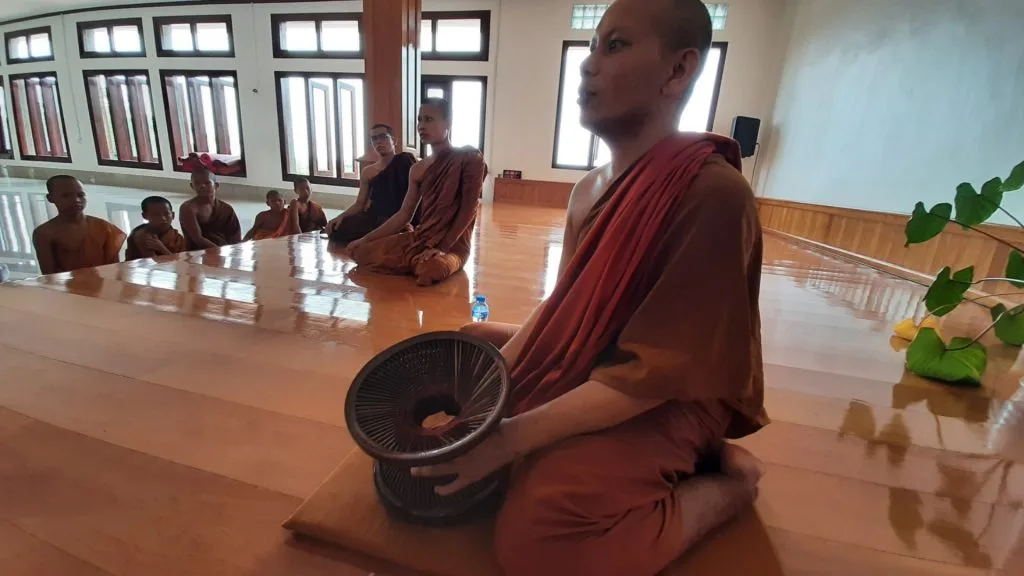
Ajahn Kola
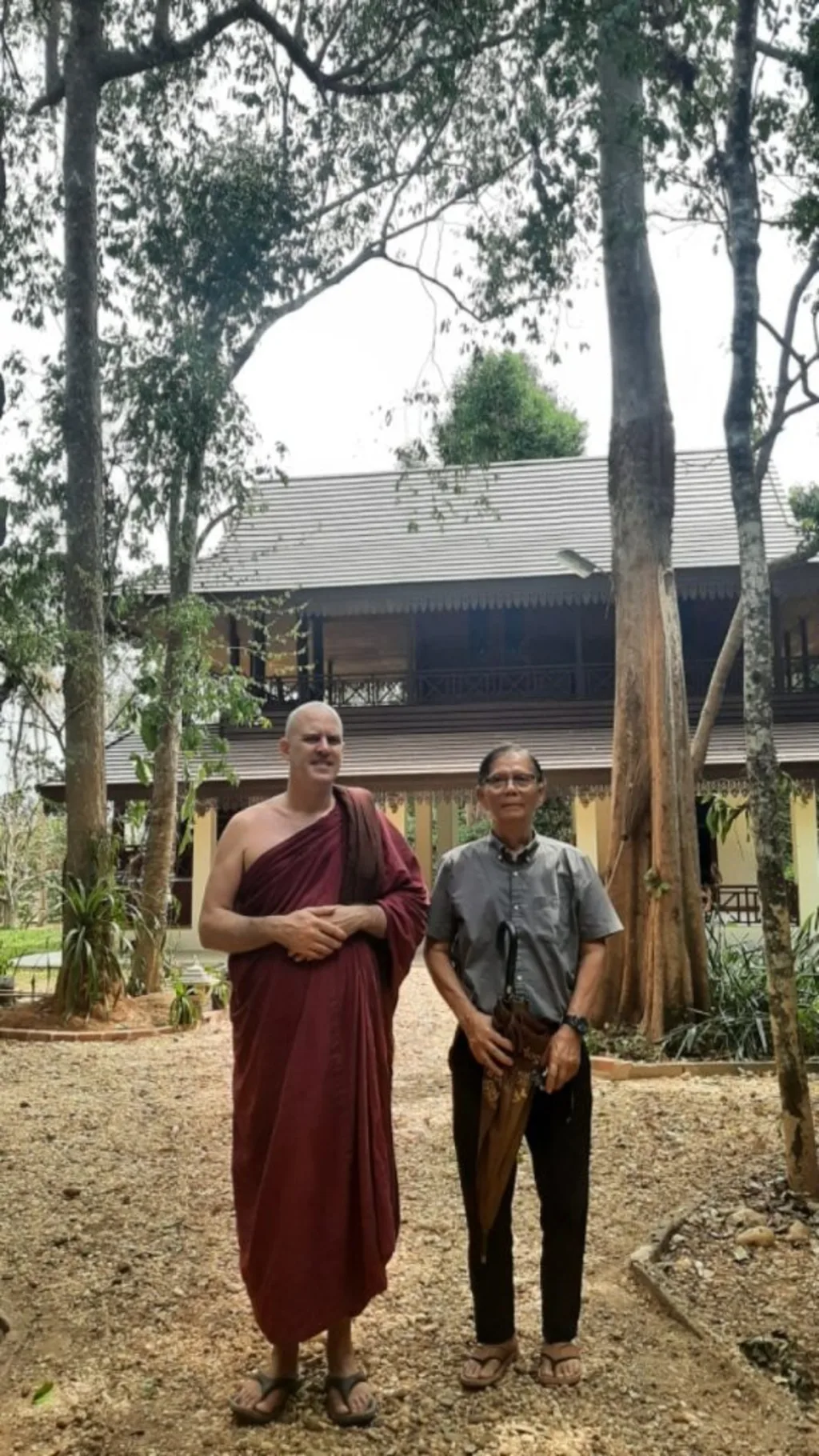
Ajahn Sam’s kuti

Getting food with Ajahn Sam
Ajahn Kola has a very large monastery with about 15 monks who are mostly novice monks. I arrived in the evening and went for alms in the morning. Going for alms in Laos was a nice experience. We too also drove by truck to a nearby village and went for alms there. This monastery eats only one time per day and about half of the food was provided from alms and the other half was cooked by the novice monks. Ajahn Kola does not want women living in the monastery, and it is allowable for novice monks to cook. However, novice monks are kids, and they were the ones preparing our meals. They did a pretty good job though. We have a chant about the food.
“Wisely reflecting, I use this almsfood. Not for fun, not for pleasure, not for fattening, not for beautification. Only for the nourishment and maintenance of this body, for keeping it healthy. For helping with the Holy-life. Thinking thus, “I shall destroy old feelings (of hunger) and not produce new feelings (of overeating). Thus there will be freedom from physical discomfort and living at ease.”
…
paṭisaṅkhā yoniso piṇḍapātaṃ paṭisevāmi – …
Laos is a very beautiful country. There is a direct inverse correlation between “developed and beautiful”. It reminded me of the times when I first arrived in Myanmar back in 2001. I hope you can visit Laos soon. There is a lot of development happening, and soon that beauty will be lost. China is spending a lot of money in Laos. Usually when they do this, they do not really help the economy but instead cause the countries to fall deeper into debt. Time will only tell what the outcome will be. In the end, a new railway has been built by China and many can benefit from it.
Both Ajhan Kola and Ajahn Sam are on a mission to give the Lao monks the training they need in order to continue the Theravada tradition. Having properly educated monks is a big problem in Laos. Their mission is to develop the monks, and they both have become quite well known. Both of these leaders have sent some of their monks to IIT, Sri Lanka right now. Ven Devananda and his crew (The leaders of IIT) also feel the same way and that was why IIT was established in the first place. Ajahn Kola is very fluent in English and he took the time to show me around. We had some very nice conversations about his monastery and mission in life.
In the afternoon, we left and then went to the Capitol city near the Thai border. We visited one of the Lao lady’s who was in Kaua’i when I was there in 2015, and 2018-19, and then we crossed the border. It was strange to see another person from Kaua’i in a remote area so far away. The world is very small. She is in the picture from Sukho Thai Restaurant in this post here.
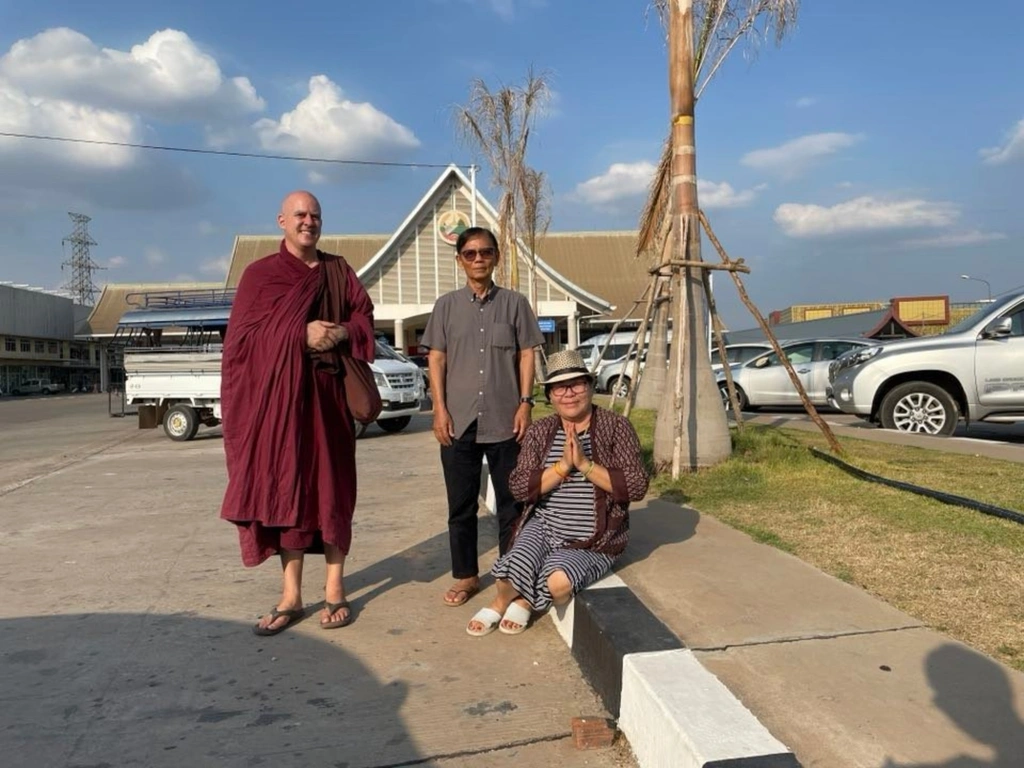
At the Thailand-Laos Friendship Bridge (for crossing the border)
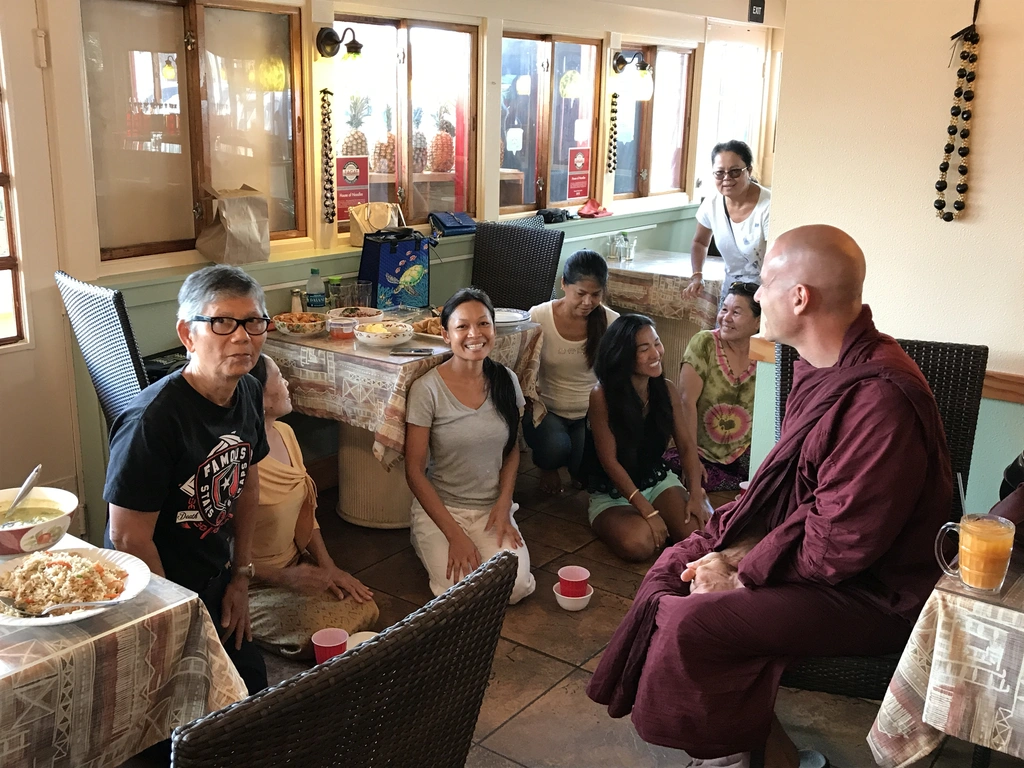
Sukho Thai Restaurant, Kaua’i Island, Hawai’i, 2019
When I came back to Uncle Sam’s village, again we would follow the same routine where I would be dropped off for the alms and meal and then picked up later. There was a heat wave and Uncle Sam had air conditioned bedrooms. I had some health problems due to the Sri Lankan heat so I spent most of my time in the bedroom. Uncle Sam would do the same, but he also work on his water tank and solar water pumps for the banana farm. He will return to Kaua’i in a month and wants to settle his farm before he leaves.
Focus on Death
In a previous article, I explain how Buddhist monks should focus on death. Next to the forest monastery and part of the forest monastery is a crematorium. I asked if I could sleep there and it was allowed. I spent 3 nights there and “camped out” with a self standing mosquito net (if you know what they are). We cleaned the area and Uncle Sam was “on call” if I got too afraid and wanted to go home. On the very first night of all nights, there was a rare and strong thunderstorm. It was a nice time, but I was most afraid of the “living humans” who might visit and party and do drugs there. Luckily nobody came and I was fine. It was a nice experience, but 3 nights was enough. After that, it was back to Uncle Sam’s farm again.

oven
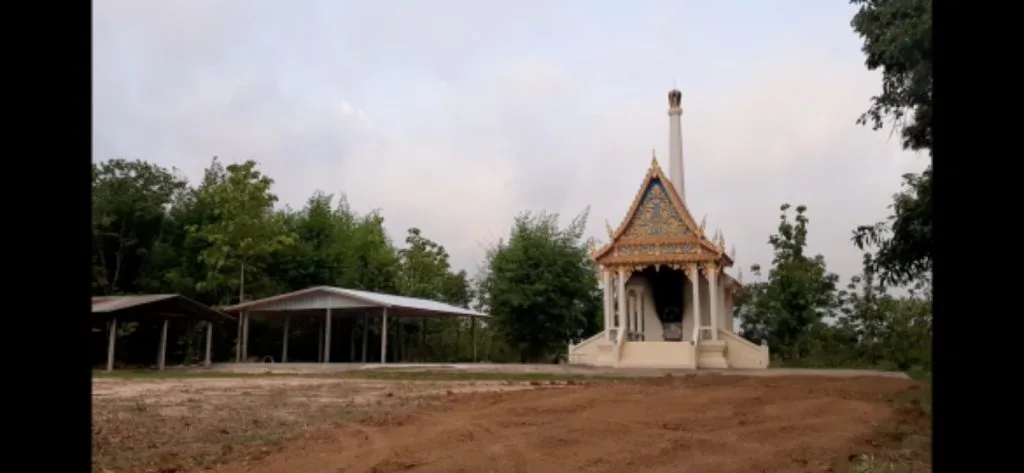
I slept in the open pavilion to the left
Above, on the left is the place where they burn the dead bodies. Most villages and monasteries have these places. This one is within the border of the monastery but you would never know it. It is separated by quite a distance. The picture on the right is an open pavilion that provided more shelter from the rain. I slept there on subsequent nights.
A Small Meditation Retreat
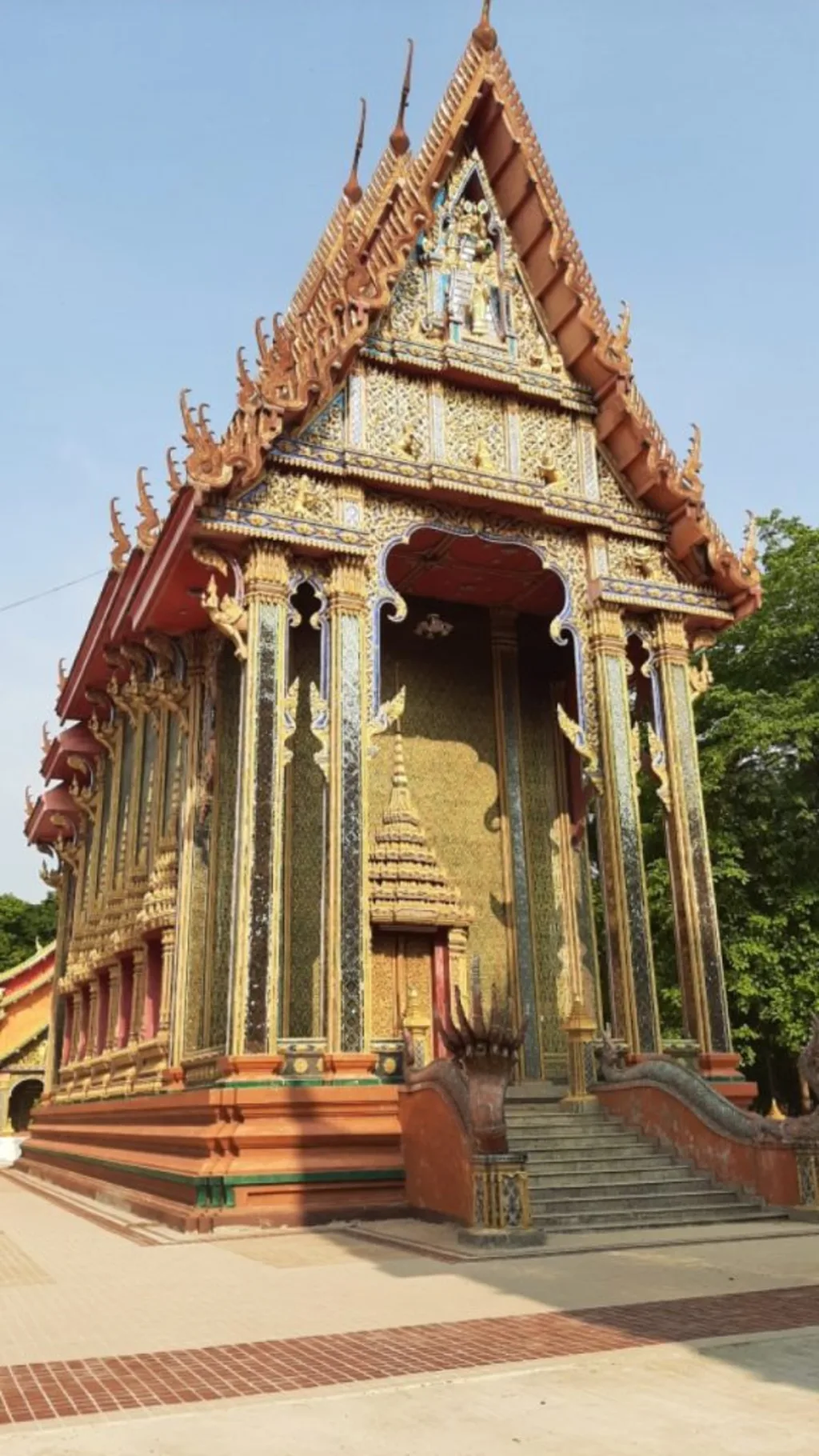
Sīma for Wat Nong Panau
The next pātimokkha day was coming up, so I started to look for another place to go. I was invited to come back to Wat Wai Kooktharam, but I was embarrassed to show up again because I felt like I was forcing my international style of pātimokkha on them. I pronounce the words differently and I know what it is like from years living at Myanmar monasteries. However, I just wanted to listen to the pātimokkha rather than chant it myself. We called them and I asked them if they knew a monastery that does the pātimokkha. They told me about Wat Nong Panau. This monastery is right outside Nong Khai. It is rumored to be the same place where Ajahn Sumedho decided to throw away his guitar and follow Buddhism but it says differently on his Wikipedia page. Whatever the case may be, later he went to live with Ajahn Chah. Uncle Sam and I drove there and although they told me they didn’t recite the pātimokkha outside of the rainy season, I was invited to stay for a visit and handed a key to a guest kuti before I could confirm. They had an English speaking meditation teacher living there as well, so I agreed. I would go for alms in the village/city with the meditation teacher, and we could eat the monastery food or eat with the food we collected. There was no truck or helpers to carry the food. It was the normal way to collect alms. I was really happy to be at that monastery. I learned or was reminded of a simple mindfulness technique and I found it very useful.
The monastery was well supported and had about 15 monks. However, the leaders of the monastery were quite young for such a developed monastery. Although they teach meditation at this monastery, I didn’t see any preaching support for the lay people. However, it was amazing to see what they have built for the monastery.
The Last Week

Learning to make strips
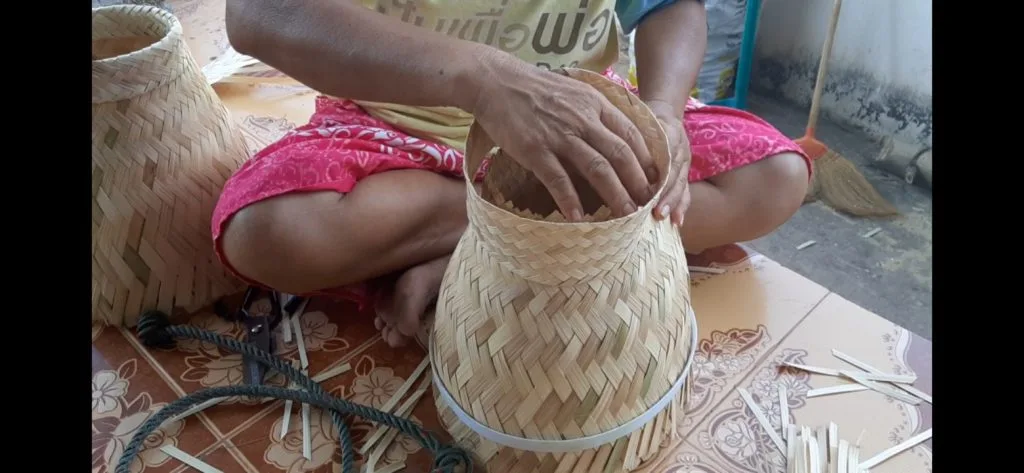
After the meditation retreat, I had one week left on my trip. The lay people in the village have a cottage industry for making bamboo sticky rice steamers. I tried to learn the art of splitting bamboo for weaving with the intention of crafting an alms-bowl stand, but it was just a little too difficult. Before I knew it, the time came for me to go back to Sri Lanka. In Udon Thani, they have a special area for monks to sit in the pre-security area as well as inside the gate. It was nice and it was used quite a lot. There are many monks and they fly a lot (including myself). Both DMK and BKK airports also have special lounge rooms for the monks as well. I had Kappiya Greg who normally lives in Myanmar host me for one night at his brother-in-law’s place in Bangkok. The next morning he drove me to the airport with food in hand. Below is a picture of him along with the food at the monk room at BKK airport.
And that was my trip!

Monk room at Thailand Airport
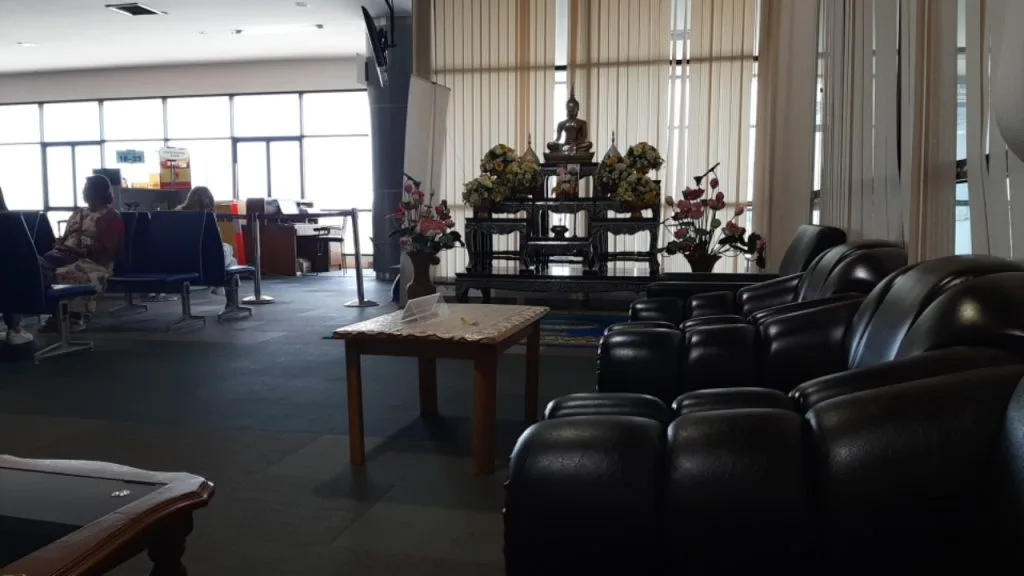
Monk Area at Gate
Conclusion:
I learned a great deal about Thai culture and monasticism within that culture. Some take away points about the culture and experience were:
The Thai monks are unified with the same chanting in all monasteries (that is really nice)
Pātimokkha was just as rare and difficult to find in Thailand as it is in Myanmar
The Thai people are wonderful and generous
Generally speaking, the Buddhist scholarship level seems to be weak in Thailand compared to Sri Lanka and Myanmar
It is just as rare to find monks who don’t use money in Thailand as it is in Myanmar
The donors who support the monasteries are very old and there are very few young people involved with Buddhism. This is very different from Myanmar and Sri Lanka and it is a concern.
If you find the right monks, they can be supportive towards vinaya monks and their practice even though they might not follow that same standard.
The roads are really well done
Healthcare is really accessible for all Thai people.
I’m back at IIT, Sri Lanka. More construction is happening and we are already a week into the semester.
Click below to search subjects